When the rest of the world thinks of Taiwanese food, night markets and Din Tai Fung (鼎泰豐) are invariably the first establishments that come to mind. Taiwan does boast one of the most exciting street food scenes in the world, and Din Tai Fung — which actually specializes in Huaiyang cuisine from China’s eastern coast — can incite a yearning for dumplings that no other can satisfy.
These are fine as introductions, but an exploration of Taiwanese cooking that starts and ends there does the cuisine no justice. As an alternative, there are two restaurants in Taipei that I think of as one-stop shops for a deeper dive into the food of the land (and sea): Shin Yeh (欣葉) and Mountain and Sea House (山海樓).
One is a family-friendly restaurant group with a range of reliable and essential dishes familiar to any local; the other serves artful banquet-style cuisine recreated from historical sources that can delight even the most jaded.
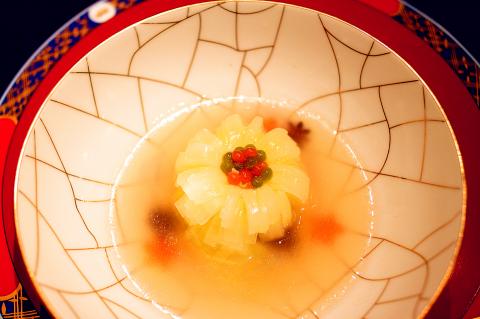
Photo: Davina Tham, Taipei Times
SHIN YEH
Shin Yeh’s first incarnation in 1977 was a back-alley restaurant, but it has since grown into a household name. Although over the years the restaurant group has developed some specialized branches that serve fine-dining and Japanese cuisine, its cornerstone remains the original restaurant line — simply named Shin Yeh — that serves homecooking-inspired fare.
Shin Yeh does have its share of luxuries, like braised whole abalone (NT$560), steamed crab with roe (NT$850), lobster (NT$180 per 37.5g) and unfortunately, despite the environmental and ethical concerns around shark finning, a handful of shark’s fin dishes. An unorthodox showstopper is the mountain of glistening, addictively crunchy dried scallop and potato shards fried to a golden crisp (NT$1,050).

Photo: Davina Tham, Taipei Times
There are also decent renditions of the usual suspects like sweet-and-salty “three cups” chicken (NT$680), steamed pork meatballs with salted egg (NT$225) and soy-braised pig’s trotter (NT$300). But I’ve found that the humblest dishes make the most impact.
An unfussy bowl of stir-fried vermicelli with julienned pumpkin (NT$200) packs a whallop of garlic and umami into each al dente strand of noodle. Preserved radish omelette (NT$210) is a straightforward, well-executed version of the homely dish, with a mild fermented funk. Soy-braised pork over rice (NT$120), with a cube of whole pork belly, is a particularly hearty version, serving up more meat than the street version that’s heavy on lard. These dishes may be common, but Shin Yeh’s on-point delivery of flavor every single time is rare.
The array of options means that Shin Yeh does double duty as a banquet restaurant for a traditional birthday feast, as well as an easy weeknight dinner spot. That might explain its evergreen popularity with locals — reservations are recommended, especially on the weekends.
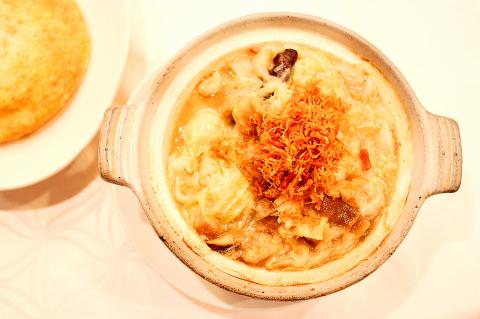
Photo: Davina Tham, Taipei Times
■ Shin Yeh (欣葉), various locations in Taipei; more information at: bit.ly/32OMpjm
MOUNTAIN AND SEA HOUSE
Going from Shin Yeh to Mountain and Sea House is a bit like moving from a freshman 101 class right into a graduate seminar, but exponentially more delicious.
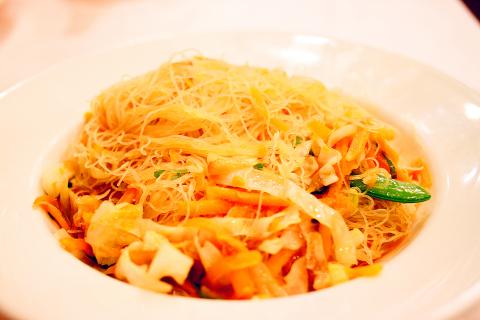
Photo: Davina Tham, Taipei Times
Though only five-years-old, Mountain and Sea House has set itself the lofty task of reconnecting diners to Taiwan’s terroir and history through meticulously researched recipes and techniques executed with local ingredients.
This often involves tracking down specific renditions of a dish and learning from the old hand that makes it, as was the case with a sweet almond milk that my server says the chef’s team learned from an octogenarian in Yilan. The dessert turns out to be my favourite dish of the night — familiar and comforting, without any of the cloying greasiness that fails other versions I’ve had.
The restaurant pays homage to Taiwan’s 1920s and 1930s banquet-style cooking that flourished into the mid-20th century before declining in popularity. The food is built on a backbone of recipes passed down to creative director Tsai Jui-lang (蔡瑞郎) from 84-year-old masterchef Huang Te-hsing (黃德興).
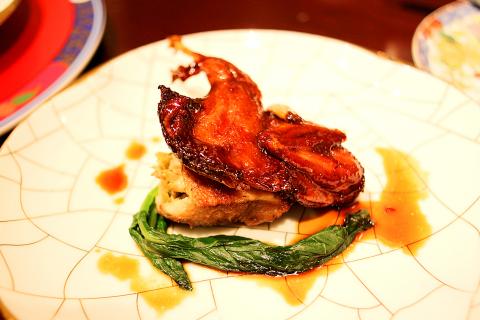
Photo: Davina Tham, Taipei Times
The nostalgia seeps into the furnishings and even the china, all modeled after a Taisho-era banquet hall. All of these efforts paid off handsomely when Mountain and Sea House acquired its first Michelin star this year.
As a banquet-style restaurant, a la carte dishes are portioned for a sizeable group, so service staff will nudge groups of four or less toward individual meal sets. At dinner, the nine-course sets start at NT$1,980 and go up to NT$4,680. Lunch sets start lower, from NT$980 on weekdays. The high prices are reflected back in the artistry on the plate.
Sets vary seasonally, but a platter of cold appetizers starts each one in largely the same way, bringing together the love-it-or-hate-it dried mullet roe and some less polarizing bites, like smoked chicken, kaoliang sausage and a squid ring filled with egg three ways.
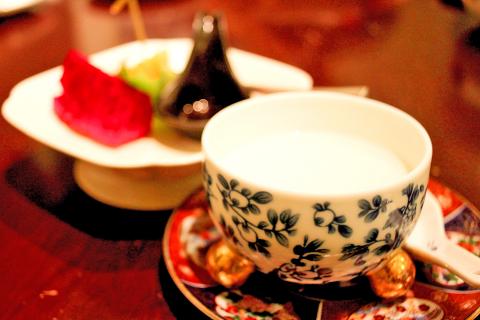
Photo: Davina Tham, Taipei Times
The restaurant shares a parent company with local organic grocer Green and Safe, so much of the produce comes from the same Nanao Fengyuan Farm (南澳豐園農場) in Yilan. Ingredients are treated with great care and skill. When my roasted squab arrives, I gnaw it down to the bone and then also try to eat the bone, at least the crispy bits, since every part of the bird is intensely flavorful.
If you’re literate in Chinese, the menu reads like poetry and adds to the banquet experience, where presentation and meaning are as important as flavor. A dish with a name that translates as “dewdrops on flowers in one’s hair” is a chicken and mushroom meatball inside a carved cucumber, sitting in chicken consomme. “Phoenix eye abalone” is named for the shape of the mollusc as it sits on a bright yellow bed of egg custard.
That said, some dishes were a little underwhelming, such as the deep-fried flatfish spring roll and stir-fried vermicelli with dried seafood. And I can’t comment on the restaurant’s signature dishes of suckling pig (NT$3,280, NT6,650 or NT$9,980) and stuffed whole chicken stewed in pig’s stomach (NT$4,800), which need to be ordered three and two days in advance respectively. They can also be sampled as part of the higher-priced set meals.
But as far as faithful reproductions of traditional Taiwanese cuisine goes, Mountain and Sea House is in a class of its own. My only hope is that, given all the fieldwork and first-hand interactions with masterchefs in the name of recipe development, the restaurant can find a way to bring more of those stories into the dining experience.
■ Mountain and Sea House (山海樓), 94, Renai Rd Sec 2, Taipei City (台北市仁愛路二段94號); Daily, 11:30am to 2:30pm and 5:30pm to 10pm; tel: (02) 2351-3345
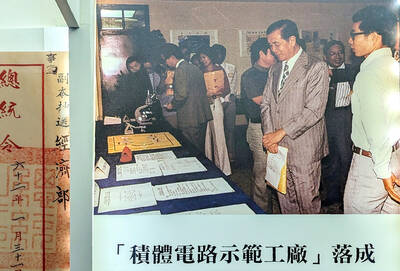
Oct. 27 to Nov. 2 Over a breakfast of soymilk and fried dough costing less than NT$400, seven officials and engineers agreed on a NT$400 million plan — unaware that it would mark the beginning of Taiwan’s semiconductor empire. It was a cold February morning in 1974. Gathered at the unassuming shop were Economics minister Sun Yun-hsuan (孫運璿), director-general of Transportation and Communications Kao Yu-shu (高玉樹), Industrial Technology Research Institute (ITRI) president Wang Chao-chen (王兆振), Telecommunications Laboratories director Kang Pao-huang (康寶煌), Executive Yuan secretary-general Fei Hua (費驊), director-general of Telecommunications Fang Hsien-chi (方賢齊) and Radio Corporation of America (RCA) Laboratories director Pan
The consensus on the Chinese Nationalist Party (KMT) chair race is that Cheng Li-wun (鄭麗文) ran a populist, ideological back-to-basics campaign and soundly defeated former Taipei mayor Hau Lung-bin (郝龍斌), the candidate backed by the big institutional players. Cheng tapped into a wave of popular enthusiasm within the KMT, while the institutional players’ get-out-the-vote abilities fell flat, suggesting their power has weakened significantly. Yet, a closer look at the race paints a more complicated picture, raising questions about some analysts’ conclusions, including my own. TURNOUT Here is a surprising statistic: Turnout was 130,678, or 39.46 percent of the 331,145 eligible party

The classic warmth of a good old-fashioned izakaya beckons you in, all cozy nooks and dark wood finishes, as tables order a third round and waiters sling tapas-sized bites and assorted — sometimes unidentifiable — skewered meats. But there’s a romantic hush about this Ximending (西門町) hotspot, with cocktails savored, plating elegant and never rushed and daters and diners lit by candlelight and chandelier. Each chair is mismatched and the assorted tables appear to be the fanciest picks from a nearby flea market. A naked sewing mannequin stands in a dimly lit corner, adorned with antique mirrors and draped foliage

The election of Cheng Li-wun (鄭麗文) as chair of the Chinese Nationalist Party (KMT) marked a triumphant return of pride in the “Chinese” in the party name. Cheng wants Taiwanese to be proud to call themselves Chinese again. The unambiguous winner was a return to the KMT ideology that formed in the early 2000s under then chairman Lien Chan (連戰) and president Ma Ying-jeou (馬英九) put into practice as far as he could, until ultimately thwarted by hundreds of thousands of protestors thronging the streets in what became known as the Sunflower movement in 2014. Cheng is an unambiguous Chinese ethnonationalist,